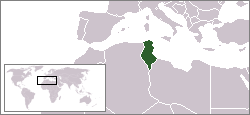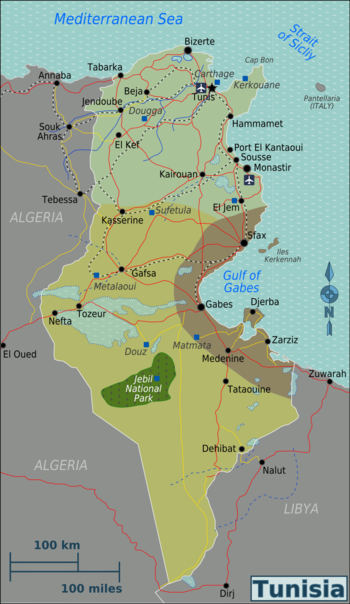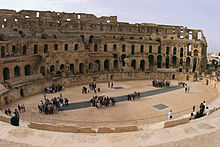 | WARNING: Due to the outbreak of the contagious disease COVID-19 (see coronavirus pandemic), caused by the virus SARS-CoV-2, also known as coronavirus, there are travel restrictions worldwide. It is therefore of great importance to follow the advice of the official bodies of Belgium and Netherlands to be consulted frequently. These travel restrictions may include travel restrictions, closure of hotels and restaurants, quarantine measures, being allowed to be on the street for no reason and more, and can be implemented with immediate effect. Of course, in your own interest and that of others, you must immediately and strictly follow government instructions. |
 | |
| Location | |
 | |
| Flag | |
 | |
| Short | |
| Capital | Tunis |
| Government | Presidential Republic |
| Coin | Tunisian dinar (TND) |
| Surface | 163,610 km² |
| Population | 9,924,742 (end 2003) |
| Language | Arabic (official, also commercial), French (commercial) |
| Religion | Muslim 98%, Christian 1%, Jewish and other 1% |
| Electricity | 127-220V/50Hz (European plug) |
| Call code | 216 |
| Internet TLD | .tn |
| Time zone | UTC 1 |
Tunisia is located on the north coast of Africa.
Info
Tunisia borders to the west and southwest Algeria, in the southeast on Libya, and at the Mediterranean in the east and north. Located on the other side of the Mediterranean Sea Italy. The Italian Islands Sicily and Sardinia lie between the two countries. Between Tunisia, like the rest of North-Africa, and most of the African continent is the Sahara desert. It is also very green, hills are systematically planted with trees, which is clearly visible in the landscape. In short, Tunisia from the car can be a good and experience. In any case, it changes the image that many tourists have; ie sea, beach, hotels and camels ... Tunisia is especially beautiful!
History
The Berbers, the original inhabitants of North Africa, have seen them all come: Phoenicians (also called Punics) from the Middle East, Romans, Byzantines and Arabs. In the course of history, these peoples have inhabited the land and left their buildings there. Part of the building has since been destroyed by successors and the ravages of time. The Arabs brought Islam with them and since then this belief has influenced life in the country.
climate
In the north and along the east coast there is a Mediterranean climate. It is also very hilly. The south ends in the Sahara, so it has a desert climate.
Geography
Tunisia is the smallest country in North Africa.
Population
Berbers and Arabs live in Tunisia. Farmers grow wheat, grapes and dates in the northern hilly landscape.
Culture
Islam leaves its mark on more recent art and culture. However, there is early medieval Christian art to admire, as well as even older Roman and Carthaginian remains. In the south is an old Jewish settlement, but a large part of the inhabitants has since moved to Israel emigrated.
Holidays
Islamic holidays are celebrated following the Islamic culture and calendar. They are therefore not tied to fixed dates in the Christian calendar. Of course, the Christian celebrations are held in the churches.
Regions
The administrative division of Tunisia has a total of twenty-four so-called governorates. The tourist can use a simpler classification:

| Northern Tunisia (Tunis) the capital Tunis, the entire north coast and mountains, furthermore Cap Bon and a number of very popular Mediterranean seaside resorts such as Sousse and Monastir |
| Central coastal strip Sfax, Gabes, the southern seaside resorts and the bus route to Libya |
| Tunisian Sahara the desert interior - rocky plains, salt lakes, sand dunes, some interesting archaeological sites. The population lives here in remarkably green oases, certainly compared to the surroundings, where all kinds of fruits and vegetables are grown in the shade of date and other palms, which temper the burning sun. |
Towns
Most major cities in Tunisia have city walls and a covered city district, the medina and a souk, an Arab shopping district dating from the Middle Ages, with narrow streets, a bit of a maze full of artisans with workshops and shops full of bargains. A craft is represented per street. This forms a colorful whole. Besides the capital, the list is limited to seaside resorts where residential tourism is concentrated.
- Tunis – the capital Tunisia and just north of it the remains of the city Carthage known from Hannibal, who traveled with elephants across the Alps to ancient Rome. The city has a very authentic souk
- Djerba – an island city in the Mediterranean in the south that is popular with "sun seekers"
- Gabes – a large oasis city on the east coast directly by the sea, transfer point to the desert
- hammammet – is on the beautiful peninsula Cap Bon convenient.
- Kairouan – An Islamic pilgrimage site
- monastir, A walled city with a ribat. Ancient city with a history dating back to Phoenician times; home to the largest charter airport in the country.
- nabeul, the capital of the Cap Bon peninsula. Just past Hammamet located on the same bay.
- sfax, the second largest city in the country after Tunis, historic city with a large kasbah; departure point to the Kerkennah Islands.
- sousse, UNESCO World Heritage Site north of Monastir. After sfax the third largest city in the country. There is a market on Sundays.
- El Kef – This small town in the northwest of the country offers Byzantine and Ottoman architecture.
- tozeur – Departure point to various towns in the Sahara.
- Tabarka – is a coastal town in northwestern Tunisia, less than 25 km from the border with Algeria. The city has about 16,000 inhabitants, most of whom work in the tourism sector. The place is best known for its coral fishing, the Coral Festival of Underwater Photography, and the annual jazz festival.
Other destinations
These places, except for the island of Djerba, are often visited as an excursion by tourists who stay along the coast in hotels that are often indistinguishable from those of Benidorm. But the more adventurous traveler can often easily find a place to sleep here. You will spend the night in Douz and Tozeur during organized multi-day trips in very simple hotels. Elsewhere people also spend the night in tents.
- Chott el Djerid, salt lake, there is only water after prolonged rainfall, otherwise grey-white and flat terrain. The area is bisected by the road between Gafsa and Douz. Mirages (fata morganas) are often seen here.
- Djerba, island and holiday paradise with hotels,
- Douz, town on the edge of the desert. On Thursdays the so-called camel market is held, but dromedaries (with only one hump) are sold. There is a hotel Sahara here with very basic rooms.

- El Djem, with the Roman Amphitheatre, large and quite well preserved.
- Gabes, is the great oasis by the sea. You can be driven around here by carriage.
- Gafsa, Roman Baths and Center for Folk Art with carpet knotting and weaving.
- Kairouan, the holy city. There are two famous mosques here and carpet knotting demonstrations in the souks.
- Matmata, here are so-called cave houses. In a large, deep pit, rooms have been cut into the walls, which form the house, in order to escape the heat of the sun. The desolate and otherworldly-looking landscape around this place was one of the locations where the "Star Wars" movies were filmed.
- Tozeur, has a small zoo with animals from the area. There is a hotel "Oasis" here.
- Carthage – Phoenician colony, largest marketplace in the past, built by the Romans, easy to reach by train from Tunis.
- dougga – Impressive ruins of a remote Roman city.
- Jebil National Park – A large national park in the Sahara with impressive sand dunes and rock formations.
- Church Customs – Remains of a Punic settlement listed as a UNESCO World Heritage Site.
- matmata – Desert village with cave dwellings where in the film Star Wars the town of Tatooine was located.
- Metlaoui – Board the historic train and enjoy the dramatic scenery.
- sufetula (Sbeitla) – A well-preserved Roman settlement in the center of the country.
Arrive
Passport and visa
Your passport must be valid in the period from arrival to your departure (and often for six months after the departure date). A visa is not required for a tourist visit shorter than three months. For people who have booked a package holiday, an identity card is sufficient.
By plane
Tunisian is the national airlineAt Tunis, Monastir and Djerba and since 2010 Enfidha (between Monastir and Tunis) are international airports. Tunisair uses Tunis/Carthage and Monastir for scheduled flights, while the other airports are also used by charter flights. The completely new airport Enfidha was officially opened on 15 February 2010 by President Ben Ali. Flights to Enfidha are being launched in phases. From Europe there are already airlines that fly to Enfidha, for example transavia from Amsterdam and jetair from Brussels.
By car
In order not to have to drive around the Mediterranean Sea by car, one can Netherlands or Belgium by car to Marseille, Genoa or Salerno drive and take a car ferry there. See below for further information.
By train or bus
Travel by train or bus to the chosen port city and use the boat from here.
By boat
One can take a car ferry [1] use, to Tunis, (La Goulette) or sfax from the following ports:
- Genoa and Marseille with shipping company Societe Nationale Maritime Corse Mediterranee (SMCM)(CTN).
- Genoa with shipping company Grandi Navi Veloci (GNV).
- Salerno, with the Grimaldi Ferries Prestige shipping company.
Ferries also sail from Malta and Sicily. For a crossing in the busy summer months it is necessary to book at least three months in advance.
Travel around
By plane
- Tunisian is the national airline
By train
Along the east coast there is a train from Tunis to Gabes via Hammamet and Sousse, among others. The city of Monastir has a connection to Sousse through the Metro du Sahel, a light rail connection. Guests of the hotels located north of Monastir's airport can also travel to and from these cities.
By car
If you don't go with your own car but take a flight to one of the larger international airports, there is always the option to rent a car. The prices at the internationally known landlords can be found via the internet. Sometimes it pays to look for a car rental company in the city of residence that only rents to foreigners. You often have half the rates and relatively good cars, albeit without ABS, because that is not mandatory in Tunisia. There are relatively good motorways, reminiscent of France, local roads are generally fine and the signage is correct. A navigation system is sometimes available from a car rental company.
By taxi
It is nice about countries such as Tunisia that taxi transport can be very affordable. You often have to negotiate, but then you can travel around very comfortably with private transport. An example of such a company is Taxi Touristique [2]
By bus
There are travel agencies in every city that organize excursions to places of interest, but there are also bus lines, which mainly connect the larger places. There are also the so-called louages or taxis-brousse these are taxi buses for 7-12 people, which cover a specific area. A colored stripe on the bus indicates which area they cover. It is a way to get to know the local population, because they make massive use of this means of transport.
By boat
There is not much water in Tunisia, only the Mediterranean can be sailed. From the port of sfax are the Kerkenna Islands, Cherquic and Gharbi accessible by boat. Also to and from the island Djerba there are boats.
Language
Arabic is the official language, in the trade is also French used. The man of a souvenir shop will address you with "Look, look, don't buy" or with "i'll make you nice price"
To look at
To do
To buy
You are not allowed to import or export the Tunisian dinar (1 TND is approximately 0.52 euros). You can exchange at the airport, port, banks or hotels. ATMs are available in most cities. Furthermore, you may not enter more than 400 euros in cash. Finally, the rule applies that you may not exchange back more than 30% of what you bought in dinars, with a maximum of 100 dinars. Keep your receipts if you think you will exchange them.
The craftsmen's products are offered all over Tunisia. Carpets, silver and copperware and clothing and leather goods.
gratuities
Tipping is a part of life in Tunisia as a token of appreciation. Incomes are low.
Food
Given its location south of the Mediterranean, it is not surprising that Tunisian cuisine is part of North African cuisine. Western dishes are often served in hotels, with local dishes from time to time.
Going out
Usually entertainment is given in the big hotels for their guests. But there are more options, such as in Sousse and Hamamet; by European standards it is a mediocre nightlife, but the tourist goes for example to cross-dressing shows that are very popular, regularly in the Casino of Sousse (as a casino out of use) but in use as a theater, as well as in Hamamet. The shows can be summarized as colorful dresses, exuberant wigs, and playback show. In Sousse there is also a decent discotheque 'The Saloon' in the subterranean vaults under a restaurant, but it is atmospheric. It is near the casino and the famous steakhouse, which serves Argentinian steak.
Port el Kantaoui is worth a trip. It is located north of Sousse and built especially for the tourists. There are also several golf courses in El Kantaoui and in the vicinity of Hammamet. Tunis also offers some options for going out, but it is sometimes a quest.
stay overnight
In Tunis and along the coast are hotels, with all amenities, but on such a large scale that it sometimes becomes very massive.
To learn
To work
Safety
The situation in most parts of Tunisia is stable.
There are frequent demonstrations, especially in the cities, which are increasingly accompanied by vandalism. Although the demonstrations are not initially aimed at foreigners, anger could quickly degenerate into actions against foreigners who happen to be present. You are advised to exercise extra vigilance, to avoid demonstrations and gatherings and to keep abreast of local news and current affairs. Traveling in the evenings is not recommended.
The state of emergency is currently still in effect. Due to the security situation on the ground, it is strongly advised to avoid the area along the Tunisian-Libyan border, especially the border crossings.
Travelers are advised to follow the directions of the local authorities under all circumstances and to always carry (a copy of) their passport with them. It is advised not to take photos and/or video recordings of government buildings and demonstrations. In general, Tunisia is safe for tourists as long as they stay in the tourist areas and follow the rules.
Health
You can quietly drink water from the tap, but mineral water from a bottle is also good. The health care system in the country is at a decent level.
respect
Tunisia is an Islamic country with the customs and customs that go with it. When you stay in the hotels along the coast, you will hardly notice it. Even in most tourist centers it seems like you are in Europe. Nevertheless, it is important to behave properly and not to give offense. This means, among other things, respecting the dress code when visiting mosques and other religious places. Usually it is sufficient to have the shoulders and knees covered, but sometimes long pants and long sleeves are appreciated. However, wearing footwear is not allowed in the mosque again, so make sure you have footwear that you can easily put on and take off if you plan to visit many of these religious sites.
It is not customary to openly show affection on the street. Try to take this into account as well.
It is rude to use the left hand to give or take things or money. In the tradition of the country, the right hand is the clean hand (to eat with) and the left hand is the dirty hand (to clean your behind). If you make the mistake of using your left hand to hand over money you will sometimes find that people don't take it and wait for you to switch hands.
The Tunisian is generally fond of his country. He/she is proud. Yet making contact is often easy. The Tunisian is generally hospitable and appreciates interest. This is particularly noticeable in rural areas. The language is important, people speak French and Arabic, in English it is reasonable to communicate, especially with young people and the highly educated.
Contact
| This is a usable article. It contains information on how to get there, as well as the main attractions, nightlife and hotels. An adventurous person could use this article, but dive in and expand it! |
| Countries in Africa | ||||||||||||
|---|---|---|---|---|---|---|---|---|---|---|---|---|
|
| Destinations | ||||||||
|---|---|---|---|---|---|---|---|---|
|

